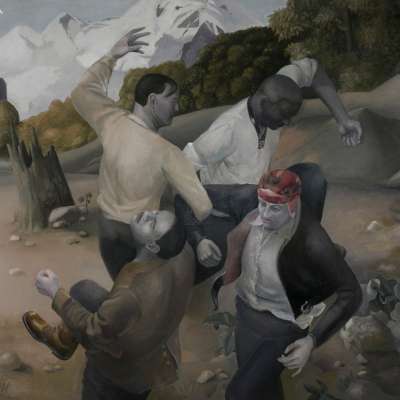Semichov&Kuzmin
Crowd psychology
The names of the paintings "Dance" and "Music", borrowed by Alexey Semichov and Andrei Kuzmin from Henri Matisse, as well as the certain caricature spirit of these works, can produce an erroneous impression of author's frivolous mockery. Meanwhile, they expressively illustrate the topic of collective consciousness, once so popular among such outstanding philosophers as Gustave Le Bon and Sigmund Freud.
In "Group Psychology and the Analysis of the Ego" Freud wrote that despite all prohibitions and restrictions imposed on a person by the society, he regularly breaks these bans, especially during the holidays that were originally nothing but short-term repeals of all prohibitions, this is why they have such a cheerful nature. This feature is characteristic for both primitive celebrations of ancient Romans and the modern carnivals.
The musicians and dancers of Semichov-Kuzmin fly into a passion unaware of such alarming signals as the cracked ice under their feet or the dead nature around them. They are rapidly losing ability to think, and the orchestra drums are already mixed with transmission. The participants of this collective madness do not notice, and even encourage the end, which invariably follows violation of a taboo. But violation of which taboo do they celebrate? There is nothing similar to a mass orgy or even a banal drinking?
In 1895, in the book "The Crowd: A Study of the Popular Mind" Lebon gave a brilliant description of the crowd psychology, which is still relevant:
— The crowd frees the individual from consciousness of his nonentity and powerlessness. In a large group of other people he feels invincible power, enhanced by the anonymity, that dispenses him from any responsibility for committed acts. Thus the crowd can experience such feelings and complete such actions that are impossible for an induvidual.

“Semichev–Kuzmin”. The project was founded in 1993. The artists arranged four solo exhibitions and participated in several projects New Academy of Fine Arts by invitation of T. Novikov.
Alexey Semichev
SemichevAlexey(1959) — painter, member of the “Mitki” artgroup(1984–1991), author of the “Semichev–Kuzmin” project.
Education
- Studied in Suvorov’s class at the art studioof the Houseof Medical Workers(1975).
- Graduated from the Faculty of artistic design of Mukhina Leningrad Higher Arts and Crafts College(1982).
Ledchildren's art studio, worked as a painterand decorator, worked in advertisingand design.
- Member of the“Mitki” art group in the 1990’s.
- In the end of 80s left the “Mitki” and began working with A.Kuzmin
- Member of the Unionof Artists
- Member of the CreativeUnion of Artists.
Works are presented in the following collections
- State Russian Museum,St. Petersburg;
- Museum“TsarskoyeSelo” in Pushkin;
- Central Exhibition Hall“Manege”,St. Petersburg;
- Museum of NewAcademy of Fine Arts, St. Petersburg;
- Museum of Contemporary Art in Novosibirsk.
Andrey Kuzmin
Born in 1969in Leningrad.Permanent participant ofexhibitions with the “Mitki” artgroup (1987–1992), “Vasilki” group (2010–2013) and “KoldovskiyeKhudozhniki” (2014).
Inthe early 90's together with A.Semichovcreated a “Semichev–Kuzmin”project, where they emphasized the brutalityandtechnocraticaspects of thedevelopment of civilization.Participatedin several projectsof The New Academyof Fine Arts by T.Novikov andworked inmedia art. Also knownas a poet and a writer.
In2010AndreyKuzmin, I.Vasilyevaand A.Goriaevorganizedan artgroup “Vasilki”which stood for the principlesof pure painting, freelandscapemannerand simple art means.
In 2009the publishing house “KrasnyMatros” published a book of his poems“Storiesfrom the underground” which immediatelyattracted attention ofliteraturelovers and public in general.
In 2011and 2012 AndreyKuzminwas included in thelist of nominees forthe Grigoryevpoetic award.
Works are presentedin the following collections
- Central Exhibition Hall“Manege”,St. Petersburg;
- Museum of Nonconformist Art, St. Petersburg;
- Museum of NewAcademy of Fine Arts, St. Petersburg;
- Arkhangelskregional museum.





